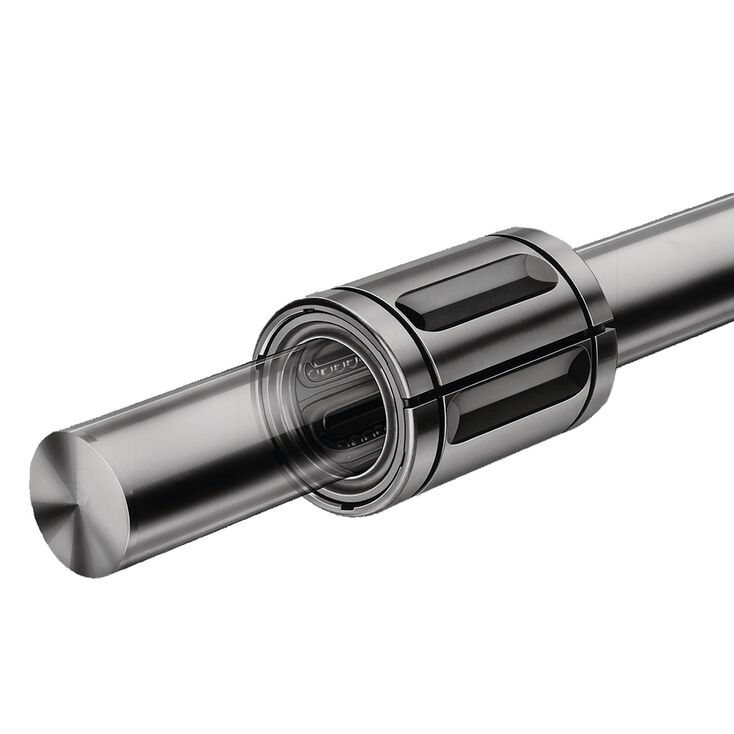Bushings

 Introduction to Bushings Bushings are an extremely reliable, efficient, durable, and economical linear motion solution that can be used in an almost never ending list of applications. The format of bushings allows for it to be constructed in a large variety of shapes, sizes, and alternative designs. Applications Instead of using a profiled rail, linear bushings are a less expensive product that can be used in many different scenarios. Some examples are:
Introduction to Bushings Bushings are an extremely reliable, efficient, durable, and economical linear motion solution that can be used in an almost never ending list of applications. The format of bushings allows for it to be constructed in a large variety of shapes, sizes, and alternative designs. Applications Instead of using a profiled rail, linear bushings are a less expensive product that can be used in many different scenarios. Some examples are:
- Self supporting guides that are only supported at the ends
- Can be used on shafts rather than specific rails
- Linear sets with iron, steel, or aluminum housings
- Commonly used in medical, food, and industrial industries
- Applications under vacuum
Benefits of using Bushings
- Maintenance-free guides
- Linear bushings don’t require much lubrication
- Rugged and able to perform without damage
- Corrosive environments
- There are corrosion resistant bushing options
- Functions in high temperature environments above 100 degree Celsius
- Linear Guides operate with low friction
Pricing
If this is a product that can be useful for your Senior Design Project, please contact a Bosch Rexroth representative here for more information. Pricing can be determined on a case-by-case basis. Resources Linear Motion Technology Handbook. Linear Motion Technology Handbook, Bosch Rexroth, 2007. Instructions and Linear Bushings Shafts Bushing Theory
Bushings are an extremely reliable, efficient, durable, and economical linear motion solution that can be used in an almost never ending list of applications. The format of bushings allows for it to be constructed in a large variety of shapes, sizes, and alternative designs. The bushings typically run on hardened and ground precision steel shafts. In contrast to other linear guides, the design of the bushing allows for an extra degree of freedom that compensates for inaccuracies in a mounting base. Bushings can be assembled as a linear bushing or as a linear guideway bushing. Linear bushings work independently or as a linear guideway bushing. A linear guideway bushing serves as a mobile mounting platform for other products. Below are examples of the linear bushing and the linear guideway bushing respectively: 

The first linear bushing image shows a great concept of how the balls circulate in a constant oval geometry to provide constant motion. Constant circulation of the steel balls create a seemingly friction-less environment for mechanical projects. Minor lubrication may be needed for higher loading projects but this product requires minimal maintenance. Housings for the bushings may take on many forms, which opens the door for limitless applications. There are three types of bushings that can be selected: Closed-type, Open-type, and Adjustable linear bushing. Closed-type bushings are typically used in a specific circumstance where the bore and radial clearance of the bushing is constant. Open-type bushings are helpful for reducing the amount of deflection on the shaft. Adjustable linear bushings allow for an adjustable radial clearance of the bushing to the shaft.  Use the naming conventions page as well as the selection page to find out more about the Bosch Rexroth bushings! Bushing Naming Conventions
Use the naming conventions page as well as the selection page to find out more about the Bosch Rexroth bushings! Bushing Naming Conventions
 Ball Retainer- The rows of balls circulate in closed circuits in the ball retainer. Typically allows for the first row of balls to be in contact with the shaft, while the re-circulating balls are not subjected to loading. Steel Sleeve/Steel Segmented Loading Plates– transmits the forces applied from outside to the balls. Seals and Holding Rings- The seals protect the linear bushings from contamination and the holding rings keep the steel load-bearing plates in the desired position. Precision Steel Shafts- Precision steel shafts are available as solid
Ball Retainer- The rows of balls circulate in closed circuits in the ball retainer. Typically allows for the first row of balls to be in contact with the shaft, while the re-circulating balls are not subjected to loading. Steel Sleeve/Steel Segmented Loading Plates– transmits the forces applied from outside to the balls. Seals and Holding Rings- The seals protect the linear bushings from contamination and the holding rings keep the steel load-bearing plates in the desired position. Precision Steel Shafts- Precision steel shafts are available as solid
and tubular shafts. There are shaft support blocks or shaft support rails for holding the shafts. Just like the linear sets, these standardized units can significantly reduce installation time. No expensive joining structure is required because the shaft is simply fastened by screwing down the block or rail. Shaft Support Blocks- The precision steel shafts can be fastened using shaft support blocks, without the need for any further processing. The shaft is slid into the bore in the shaft support block and fixed with a set screw.  Shaft Support Rails- The use of shaft support rails prevents shaft deflection. To fasten the shaft to the shaft support rail, radial threaded holes must be made in the shaft along its entire length to accommodate the fixing screws for joining the two parts.
Shaft Support Rails- The use of shaft support rails prevents shaft deflection. To fasten the shaft to the shaft support rail, radial threaded holes must be made in the shaft along its entire length to accommodate the fixing screws for joining the two parts.  Ball Recirculation- The type of ball recirculation is an important distinguishing feature of linear bushings. This has a direct effect on the linear bushing’s load capacity and its overall dimensions. Tangential Recirculation- In tangential recirculation, the balls are returned
Ball Recirculation- The type of ball recirculation is an important distinguishing feature of linear bushings. This has a direct effect on the linear bushing’s load capacity and its overall dimensions. Tangential Recirculation- In tangential recirculation, the balls are returned
to the load-bearing zone from the side. These linear bushings are distinguished by their small space requirement (small outside diameter). This
group comprises: 1. Compact and eLINE linear bushings 2. Super linear bushings 3. Standard linear bushings 4. Segmental linear bushings 5. Torque-resistant linear bushings 6. Linear bushings for combined linear and rotary motion Radial Recirculation- In radial recirculation, the ball return channel is
located above the load-bearing zone. This construction principle permits a larger number of load-bearing rows of balls for the same shaft diameter and therefore higher load capacities. This group comprises of Radial linear bushings. Bushing Selection Guide
Bosch Rexroth Bushing Selection
Selecting products can be challenging, but Bosch Rexroth has made it easy. Use the link HERE to use the Bosch Rexroth configurator tool. This tool is a streamlined approach to select the right product for your application. Following the configurator link will take you to this page:  Clicking on the configurator buttons allow you to properly design a working bushing assembly. At the end of the configurator process, a bill of materials will be generated with the bushing of your choice. Using this bill of materials, a quote can be generated by the Bosch Rexroth team. Here are some selection criteria that may be helpful for your project: Deflection- When deflection must be avoided, high rigidity is required and shaft support rails and the appropriate open-type linear bushings are necessary. If deflection is less important, more economical closed-type linear bushings (possibly with shaft support blocks) can be used. Vertical space requirement- The available construction height and the height
Clicking on the configurator buttons allow you to properly design a working bushing assembly. At the end of the configurator process, a bill of materials will be generated with the bushing of your choice. Using this bill of materials, a quote can be generated by the Bosch Rexroth team. Here are some selection criteria that may be helpful for your project: Deflection- When deflection must be avoided, high rigidity is required and shaft support rails and the appropriate open-type linear bushings are necessary. If deflection is less important, more economical closed-type linear bushings (possibly with shaft support blocks) can be used. Vertical space requirement- The available construction height and the height
of the load carried will limit the size and the choice of linear bushing. Direction of loading- If the direction of loading is different from the main direction of loading, the load capacities of the linear bushing will be reduced. The deviation
from the main direction has to be taken into account by applying a reduction factor in the design calculations. Adjacent structure- It is generally best to use ready-to-install linear sets because they save time and money during design and installation. When installing linear bushings in customer-built housings, please follow the recommendations in the product catalog. Travel speed- Not all types of linear bushings can be used when the velocity required is greater than 2 m/s. Preventing rotary motion- If rotary motion must be prevented in linear bushing guideways with only one shaft, torque resistant linear bushings must be used. Environmental conditions- Some types of linear bushings are better suited than others for particular environmental conditions because of their design. There are different sealing systems or corrosion-resistant versions to cater for different applications.
Initial selection- An initial selection of appropriate linear bushings can be made by analyzing these parameters. The tables in sections 4.1.1.5 and 4.1.2.2 also provide assistance in this pre-selection process. Normally, several types of linear bushings may be suitable for a particular application. If the type of linear bushing cannot be determined because of special conditions, you can always rely on Rexroth’s many years of experience. After selecting the type of linear bushing, the next step is to perform the design calculations.


 Parallelism in the case of two shafts-
Parallelism in the case of two shafts-
High demands are placed on the accuracy of the spacing between two shafts and their respective linear bushings and on the parallelism of the shafts and the linear bushings. Inaccuracies lead to distortive stresses or overloading and therefore reduce the service life of the linear bushing guide. The Bosch Rexroth product catalog gives recommended values for the maximum difference in spacing, including parallelism offsets. Operating temperatures- Linear bushings and shafts are essentially suitable
for a temperature range of –10 °C to +100 °C. For standard linear bushings with integral wiper seals and radial linear bushings with separate end seals, the maximum operating temperature is reduced to +80 °C (with brief peaks up to +100 °C). Higher temperatures are permitted for unsealed standard linear bushings. However, temperatures over +100°C result in a reduction in load capacity. At operating temperatures below freezing point, the formation of ice must be avoided. Shaft deflection- In assemblies with rigid adjacent structures (housings, etc.) and longer distances between shaft support points, shaft deflection and the resultant pressure between the bushing edge and the shaft reduces the service life of self-supporting guides. The exceptions are Super Linear Bushings A, H and SH with inertial error compensation up to 0.5°. Please refer to the notes in section 4.1.4.7 when calculating shaft deflection. Corrosion-resistant versions- Corrosion-resistant steels are steels to EN 10088.
In very critical, corrosive environments, the parts must be checked under operating conditions. Appropriate preserving oils and lubricants must be used.